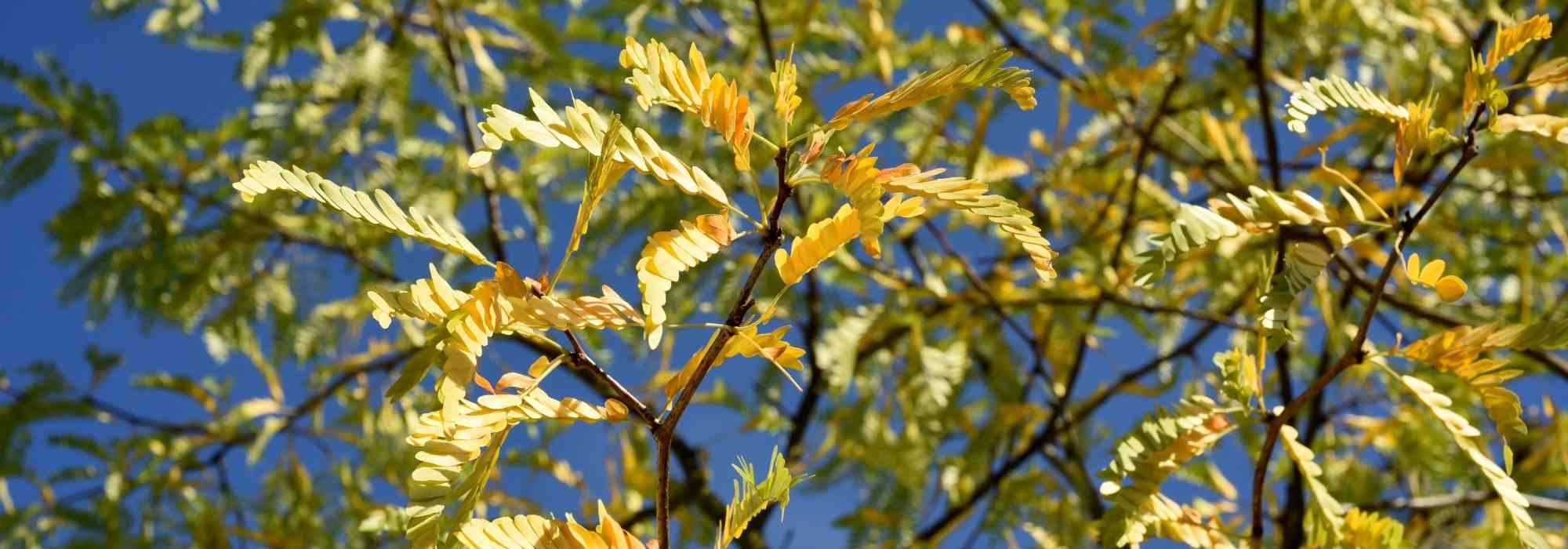
Gleditsia triacanthos, honey Locust: planting, growing
Contents
The American locust in a nutshell
- It is a tree of beautiful size with a light habit, quickly reaching about 15m in height and 10m in spread.
- Its branches bear elegant leaves cut in a fern-like shape, taking on beautiful golden or bronze colours in autumn.
- Some species are equipped with formidable sharp thorns, but there are many thornless American locusts.
- When it fruits, it produces long, very decorative pods.
- With good hardiness and low requirements, it acclimatises well throughout France.
A word from our expert
Gleditsia triacanthos, sometimes known as Honey Locust is a deciduous tree with finely divided foliage and a majestic, airy habit. Its beautiful spreading silhouette provides pleasantly dappled shade in summer. While the Gleditsia triacanthos ‘Sunburst’ features golden yellow to lime green foliage turning to coppery gold in autumn, there are also varieties with dark, purplish foliage, such as Gleditsia triacanthos f. inermis ‘Ruby Lace’. In winter, its beautifully ridged bark is revealed.
The largest specimens can reach heights of 20 m. The impressive size of this tree makes it suitable for our largest gardens. It forms a striking focal point when planted alone on a lawn, in a well-opened area, or in alignment along a grand driveway.
Hardy and easy to grow, Gleditsia triacanthos thrives in full sun in any good fertile, fresh, deep, and well-drained soil. It can adapt to wet, even waterlogged soils, as well as poor, calcareous, and dry soils in summer.
Discover this tree with dazzling foliage!
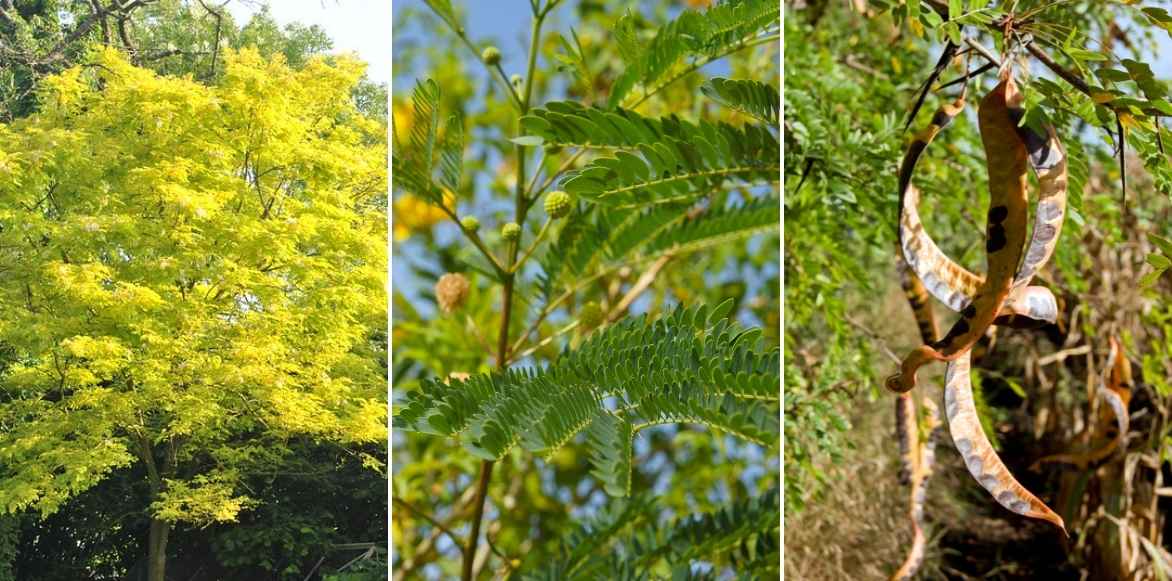
Gleditsia triacanthos ‘Sunburst’ habit, foliage, and pods of Gleditsia triacanthos
Description and botany
Botanical data
- Latin name Gleditsia triacanthos
- Family Fabaceae
- Common name Honey locust
- Flowering June to July
- Height 5 to 10 m
- Exposure Sun
- Soil type Rich, cool, well-drained
- Hardiness –15 °C and beyond
Gleditsia triacanthos, sometimes called honey locust is a tree from the Fabaceae family, a cousin of acacias and mimosa. It is primarily native to the eastern and central regions of the United States, from Kansas to Nebraska through Texas. It grows spontaneously in moist lands or calcareous soils. The genus Gleditsia comprises about 12 species. The Gleditsia triacanthos is now commonly found in our gardens in its inermous form (without thorns) as the typical honey locust features long, branched, sharp thorns on its trunk and branches, sometimes reaching up to 10 cm, which are very useful for extracting snails from their shells!
A particularity that has earned it the nicknames of thorny honey locust, three-thorned honey locust, honey locust, or Christ’s thorn. In some regions, such as Languedoc in France, this wild thorny form, often planted as a defensive hedge, has naturalised.
The typical species is available in numerous thornless cultivars selected for their habit, more modest dimensions, pods, and foliage colour, such as ‘Ruby Lace’, a magnificent variety with reddish-purple foliage.
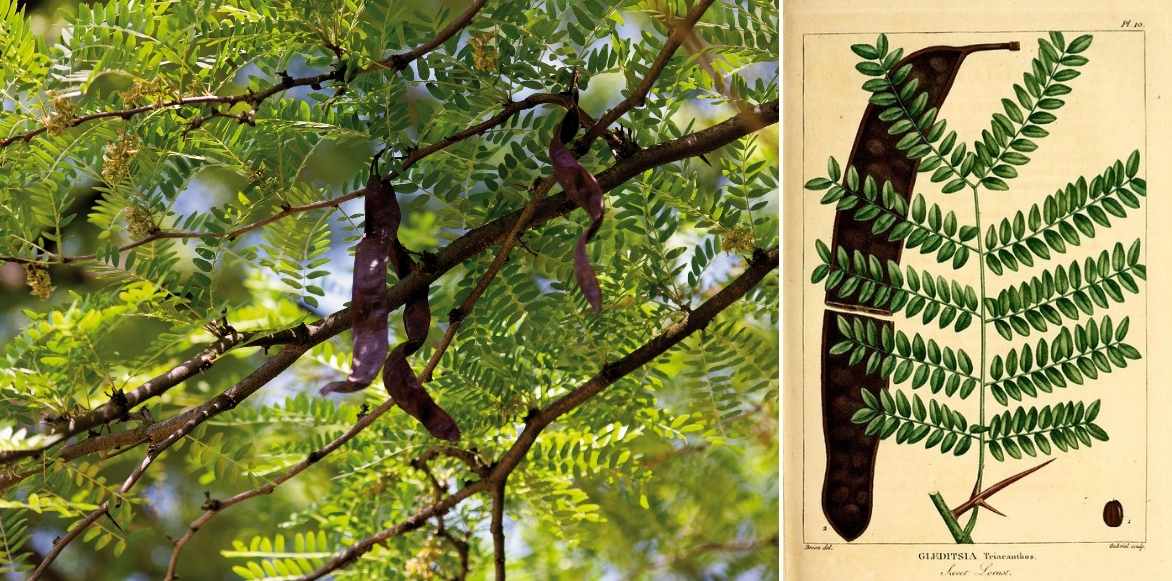
Gleditsia foliage and fruits. On the right, botanical plate from 1812
In its wild habitat, the Gleditsia triacanthos can reach up to 40 m in height, but in our regions, it will rarely exceed 15 to 20 m in height on average, with a width of 7 to 8 m. Its growth is generally rapid. Some new varieties like ‘Elegantissima’ offer slower growth and more modest dimensions, not exceeding 4 m in height and 3-4 m in width.
This tree boasts a remarkable longevity of around 150 years. It has an airy habit and a light, graceful crown. Its elegant, spreading silhouette provides light shade, reminiscent of the Black Locust, with its branches drooping in a “draped” manner. Some cultivars exhibit a weeping habit.
On a powerful, deep taproot, this beautiful tree develops a fairly tall, straight trunk with dark bark that fissures into scaly protrusions with age.
The honey locust is particularly notable for its elegant deciduous foliage that adorns itself with sumptuous hues. It disappears in autumn and reappears late, at the end of spring. As it is very close to Albizia and Mimosa, it also possesses a beautiful light, finely divided foliage. This foliage provides shade while allowing good light to filter through. It consists of long, large pinnate or bi-pinnate leaves on the same subject. They measure 15 to 25 cm long, sometimes more, and are arranged alternately on the branches. The twigs are zig-zagging. These very fine leaves resemble fern fronds. They are composed of 14 to 30 ovate, crenate, and glossy leaflets.
The foliage coloration is striking! It creates lovely contrasts and brings a lot of light to a garden. The colour of the foliage varies according to the varieties. The young leaves are initially bright dark green, golden green, or bronze-red at bud burst, then some turn to golden yellow or bronze in autumn before falling.
The flowering, discreet, occurs in June. The Gleditsia triacanthos is a dioecious species, meaning there are male and female individuals. The flowers take the form of small, greenish-white clusters. They have 3 to 5 sepals. They are melliferous and attract bees. Only female plants bear fruit. Most cultivars grown in France are male individuals and therefore do not produce pods. After pollination, the female flowers produce long, flat, spiralled pods, 20 to 45 cm long, resembling broad bean pods, in July. They start off reddish in summer and then turn mahogany in October. Hanging along the branches, they persist through winter.
They contain a sweet, edible pulp with black seeds that, when roasted, yield a coffee substitute. In their native regions, some varieties have been selected for the tangy flavour of their fruits. The leaves and pods of the Gleditsia contain triacanthin, a substance that has a tonic cardiac action.
While we use the honey locust (mainly the inermous cultivars) as an ornamental tree in our gardens, it is considered a utility tree in some countries where its very dense, high-quality wood is used to make posts, railway sleepers, or furniture, and its pods are used as a dye for the textile industry.
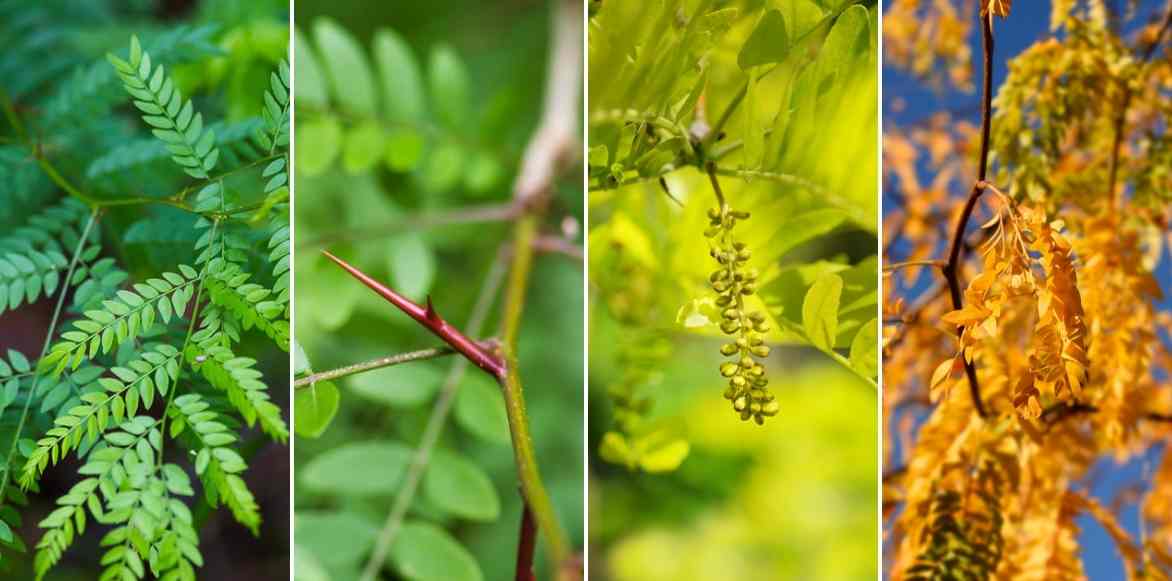
Gleditsia triacanthos foliage and typical tree with thorns (© Melissa McMasters), flowering, and golden autumn foliage
Read also
Grafting trees: different techniquesMain species and varieties
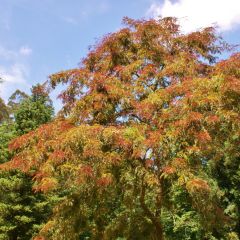
Gleditsia triacanthos f.inermis Rubylace - Honeylocust
- Période de floraison July, August
- Hauteur à maturité 10 m
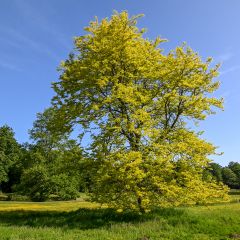
Gleditsia triacanthos f.inermis Sunburst - Honeylocust
- Période de floraison July, August
- Hauteur à maturité 10 m
Planting
Where to plant the honey locust?
Once mature, Gleditsia triacanthos is quite hardy, able to withstand temperatures as low as -15 °C, or even lower, allowing for planting in all regions. However, care should be taken with young plants, which are more sensitive to cold, and do not hesitate to protect them with fleece, especially if you live north of the Loire.
In any case, plant it in full sun, in a well-exposed and sheltered position from the wind, as its branches are brittle. It does not like draughts or strong winds. It prefers rich, moist but well-drained soils. In dry soil, this tree will develop very slowly, but will grow quickly in cool soil. Once mature, it will adapt fairly well to poor and calcareous soils, provided they remain moist. It is only moderately tolerant of acidic or overly heavy soils. Even resistant to pollution, it is a good candidate for city gardens. It also tolerates saline soils quite well and will adapt easily if your garden is by the sea.
Think carefully about the location you will give it before planting, as once well-rooted, it will grow quickly. It can become quite large, sometimes exceeding 20 m in height. It is best not to plant it too close to a house or terrace. It has a deep taproot system and often produces vigorous suckers, which could cause damage.
To make the most of its elegant silhouette and foliage, reserve a well-cleared spot in the garden for this tree. Its beautiful dimensions make it a magnificent specimen to install in isolation on a large lawn, in a spacious garden, planted near a resting area with garden furniture underneath, where it will provide pleasant shade. It can also be used as a street tree to majestically line a pathway. Its stunning colours catch the light, and it can also find its place at the back of a flower bed. The thorny species can form defensive hedges.
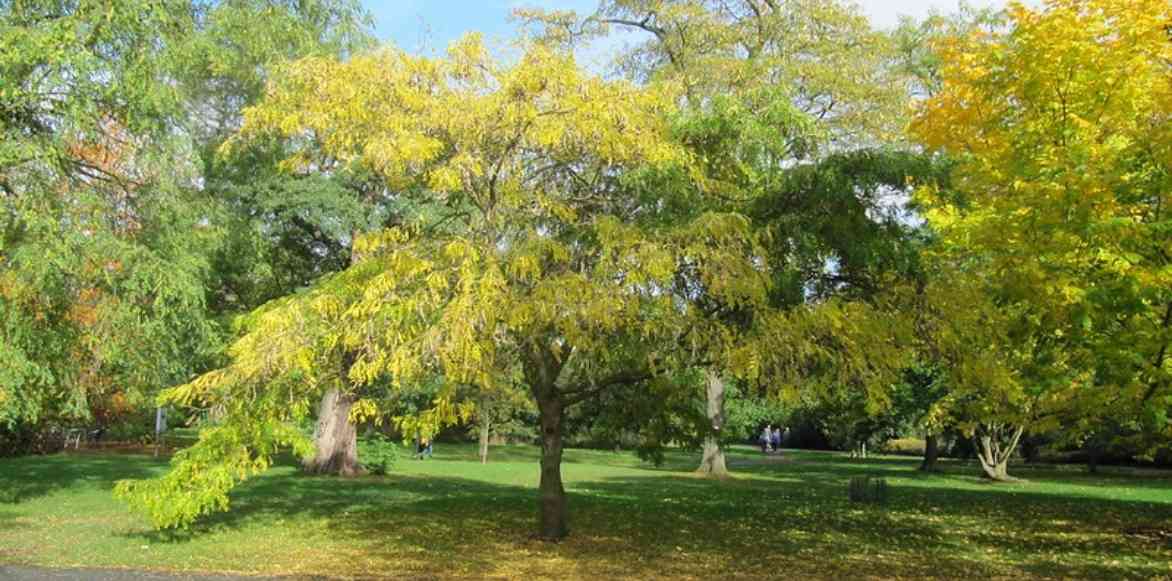
Gleditsia triacanthos (© Leonora Enking)
When to plant?
You should plant the Honey Locust preferably in autumn, from September to November, to encourage its rooting before winter. You can also plant in spring, avoiding periods of frost or extreme heat.
How to plant Gleditsia triacanthos?
Ensure it has enough space, at least 5 to 8 m distance from another tree.
- Dig a wide hole at least 80 cm in width and depth
- Add gravel or pumice to improve drainage
- Plant so that the root ball is level with the soil
- Mix compost and sand into your garden soil if it is heavy
- Install a stake to keep the young trunk upright
- Fill in with the mixture and firm down
- Water generously and then regularly until established
Read also
Trees and bushes: different habitsCultivation, pruning and care
During the first few years, monitor its water needs and water generously during dry spells. Once well established, it will better withstand temporary drought.
Young plants are fragile, which is why we recommend protecting them for winter with fleece. A good mulch in summer will help keep the soil consistently cool and in winter protect the young stump from severe frosts.
Pruning is not necessary. At the end of winter, before new growth begins, you can intervene only to remove dead, dry, or damaged wood and tangled branches to maintain the plant’s good habit. Regularly eliminate stump shoots as the tree tends to sucker.
Possible diseases
For diseases, the Honey Locust is sometimes affected by Gleditsia or locust gall midge, a small fly whose larvae deform young shoots and cause purple galls on the infested leaflets. While not serious, their presence only detracts from aesthetics. At the time of bud burst, consider pruning the affected branches.
Also be cautious of the European canker, a fungus that affects the wood: branches dry out, the bark splits, and deformities appear on the trunk. We recommend removing the damaged parts and applying a fungicidal treatment such as Bordeaux mixture.
Multiplication
The honey locust can be propagated by sowing, but this is a very lengthy process that requires a specific stratification. You can graft the tree in summer by performing a cleft graft or an English graft. Discover these two techniques in our guide and our explanations to succeed.
Associating
The honey locust is a self-sufficient species that will stand out beautifully in punctuation amidst a lawn. However, it remains easy to pair with other plants that enjoy the same very sunny environments. It will not look out of place in a large city garden or by the seaside, where it can accentuate a pathway. Stunning when isolated, it will add a vibrant touch to a mixed hedge, for example, taking over from the flowering of Japanese quince, a golden rain cytisus, lilacs, mock oranges, and deutzias.
To create a symphony of bright hues, pair it with other trees and shrubs with coloured foliage such as Ginkgo Biloba and Japanese maples. It can also be associated with the Persian Ironwood, which has flamboyant foliage in autumn, or the caramel tree and Tulip Tree, which also adorns itself with sumptuous autumnal shades.
To highlight its adornment, plant it against a backdrop of permanent greenery made up of conifers such as Pinus peuce or Macedonian Pine, or Metasequoia glyptostroboides ‘Gold Rush’.
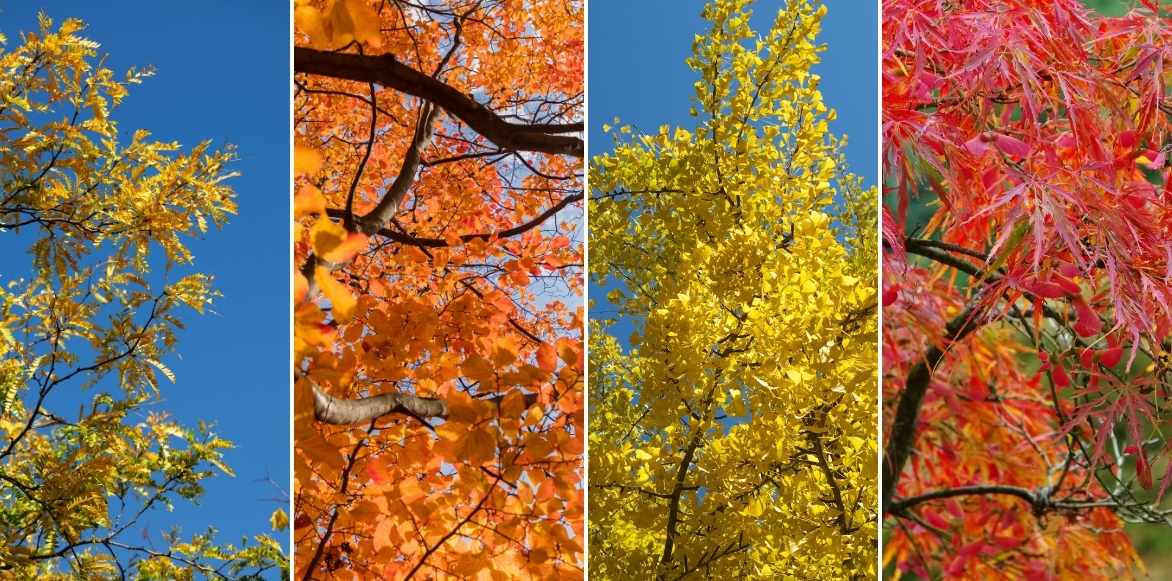
Stunning autumn colours with a Gleditsia triacanthos, a Parrotia persica, a Ginkgo biloba, and a Japanese maple!
Useful resources
- Subscribe!
- Contents































Comments